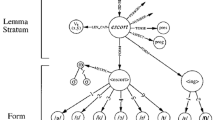Abstract
Gender priming in speech production relates to the issue of whether retrieval of a noun is facilitated by preactivation of its grammatical gender. Such gender-to-lexical entry priming has been considered the mechanism underlying the gender-identity effect in word substitution errors (i.e., a substituted word tends to have the same gender as the target word.) Gender priming was explored in two primed picture-naming experiments with German participants. Primes were presented either visually or auditorily and differed in whether they carried grammatical gender information or not. Unlike inhibition from a gender-incongruent prime, facilitation from a gender-congruent prime was weak, not reliable, and dependent on the baseline and prime modality. Implications for the interpretation of the gender-identity effect are discussed.
Similar content being viewed by others
REFERENCES
Berg, T. (1992). Prelexical and postlexical features in language production. Applied Psycholinguistics, 13, 199-235.
CELEX (1993). Lexical database [computer software]. Nijmegen, The Netherlands: Center for Lexical Information, Max Planck Institute for Psycholinguistics.
Jescheniak, J. D., & Levelt, W. J. M. (1994). Word frequency effects in speech production: Retrieval of syntactic information and of phonological form. Journal of Experimental Psychology: Learning, Memory, and Cognition, 20, 824-843.
LaHeij, W., Mak, P., Sander, J., & Willeboordse, E. (1998). The gender congruency effect in picture-word tasks. Psychological Research, 61, 209-219.
Levelt, W. J. M., Roelofs, A., & Meyer, A. S. (1999). A theory of lexical access in speech production. Behavioral and Brain Sciences, 22, 1-75.
Tanenhaus, M. K., Dell, G. S., & Carlson, G. (1987). Context effects and lexical processing: A connectionist approach to modularity. In J. L. Garfield (Ed.), Modularity in knowledge representation and natural language processing (pp. 83-108). Cambridge, MA: MIT Press.
Vigliocco, G., Vinson, D. P., Martin, R. C., & Garrett, M. F. (1999). Is “count” and “mass” information available when the noun is not? An investigation of tip of the tongue states and anomia. Journal of Memory and Language, 40, 534-558.
Wicha, N. Y., Hernandez, A., Reyes, I., Barreto, L. G. de, & Bates, E. A. (1997). When zebras become painted donkeys: The interplay between gender and semantic priming in a Spanish sentence context. Technical report 9701. San Diego: University of California, Center for Research in language.
Zwitserlood, P. (Ed.). (1990). Annual report 11. Nijmegen, The Netherlands: Max Planck Institute for Psycholinguistics.
Author information
Authors and Affiliations
Rights and permissions
About this article
Cite this article
Jescheniak, J.D. Gender Priming in Picture Naming: Modality and Baseline Effects. J Psycholinguist Res 28, 729–737 (1999). https://doi.org/10.1023/A:1023229329967
Issue Date:
DOI: https://doi.org/10.1023/A:1023229329967




